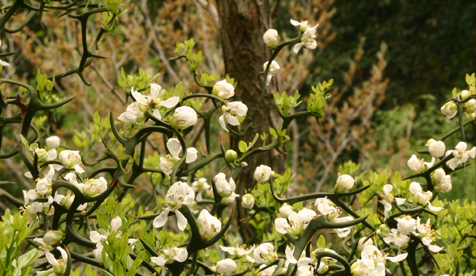As winter’s deepest chill reaches into my garden, it hesitates momentarily, for there is a dragon lurking. No, not the fire-breathing monster found in popular fiction both present and past, but rather a shrub that is both a beauty and a beast — Poncirus trifoliata ‘Flying Dragon’.
At this time of year, it is a beauty of a plant — if you adore thorns. This botanical beast is a distorted, twisted creation with claw-like, curved, 1- to 2-inch, emerald green barbs that rake at the frigid winter air. Also called hardy contorted orange, this introduction from the Far East is closely related to the citrus trees commonly grown outdoors in tropical climates, but it will readily survive in the garden in typical winters of our region.
With the arrival of spring, the softer side of this beastly plant is seen in the form of small, muted white, fragrant flowers that open in celebration of the new growing season.
In the summer, this dragon seems controlled, sleeping in a sea of handsome, glossy, deep green foliage. But come autumn after the leaves turn a pleasant light yellow and fall, its sharp talons are again unsheathed and very apparent — long, curved and gleaming in a green that remains true through the coldest of times of the year.
And since it is a member of the citrus family, also very noticeable in autumn are golf ball-size, orange-like fruits that can be considered, at best, barely edible due to their super sour, all-pit-and-little-pulp nature. The seeds readily sprout, meaning that unless the fallen fruits are picked up and trashed, this dragon could easily spring up in other areas of the garden.
This unusual bush does best when planted in well-drained, slightly acidic soil in partial to full sun. Also, if possible, place the plant in an area where it will be exposed to the low winter sun so strong light and long shadows will accentuate the visual effect of the bizarre green super thorns.
A favorite among bonsai enthusiasts, this slow-growing shrub usually only needs occasional prunings for shaping purposes and to cull out dead or broken branches. ‘Flying Dragon’ will remain restrained in habit (if not armament) to form a rounded shrub that tops out anywhere from 5 to 10 feet.
‘Flying Dragon’ could also be considered a double-duty shrub because, while one plant will make an interesting addition to any garden, 20 plants will form an impervious barrier that will keep dogs, cats and even cat burglars away.
I have seen this dragon for sale in area nurseries, but if your hunt comes up empty, it is also sold by several nurseries online. ‘Flying Dragon’ is the name to search on, but also include its botanical name Poncirus trifoliata, or you will be whisked into an e-world of wizards and magic!







